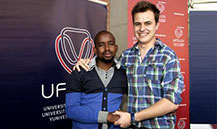 |
Ready for the task - Sabelo Khumalo, SRC President of the Qwaqwa Campus and William Clayton, SRC President of the Bloemfontein Campus.
Photo: Johan Roux
31 August 2012 |
The 2012/13 elections for the Student Representative Councils (SRC) of the University of the Free State were completed successfully and show meaningful support for the changes in student governance adopted by students across campuses over the past two years.
The SRC elections at the Qwaqwa Campus were completed on 23 August 2012, while the elections at our Bloemfontein Campus took place on 27 and 28 August 2012.
The SRC Elections at our Bloemfontein Campus showed a voter turnout of 4516 votes (30.8%), with the elections at the Qwaqwa Campuses showing 1753 votes (46%) – both campuses reached the required quorums and the IEA (Bloemfontein Campus) and IEC (Qwaqwa Campus) declared the elections free and fair and announced the results as a true reflection of the will of the student bodies at the campuses.
The full SRC at Bloemfontein Campus now consists of 62% black and 38% white, and 53% female and 47% male members.
In the Qwaqwa elections, SADESMO achieved 46, 38% of the vote, with SASCO, PASMA and NASMO each achieving 30,23% and 8,39% and 14,26%, respectively.
The successful elections at Bloemfontein Campus show that the detailed transformation of student governance introduced by students at the Campus in 2010 and adopted by the university in 2011, succeeded in mobilizing greater participation of students in governance and representation. These changes in the main included a shift to independent candidacy for elective portfolios (12 seats) and organizational candidacy in nine sub-councils that holds ex officio seats on the SRC. Changes also included the establishment of student representative seats in faculty governance and management forums and the adoption of a reviewed Central SRC Constitution. Ex officio seats hold full and equal constitutional authority in the SRC.
Students at Qwaqwa Campus introduced additional portfolios to its SRC, including ex-officio seats for academic affairs, arts and culture, commuter students, Rag Community Service, religious affairs, residences and sports.
A joint sitting of the Campus SRCs will establish the Central SRC 2012/13 on 9 September 2012.
As a further opportunity for participation in and the development of student governance and representation, the current Central SRC herewith also announces its recent adoption of a student governance advisory programme, namely the UFS Student Elders Council (SEC).
The SEC is established as a combined programme between the Central SRC and the Dean of Student Affairs and will consist of selected senior student leaders from all campuses who completed their terms of office, apply and are appointed to the Elders Council by the Central SRC.
The Council will serve as an advisory structure to the Central SRC and other student structures in support of the continuous development of student governance and representation of the student body at the university.
The SEC will advise the Central SRC to be constituted following the constitution of the respective Campus SRCs.
The SRC members at the Bloemfontein Campus are:
President: Mr William Clayton
Vice-President: Mr Bonolo Thebe
Secretary: Ms Karis-Robin Topkin
Treasurer: Mr Pieter Coetzee
Arts & Culture: Ms Chanmari Erasmus
Accessibility & Student Support: Ms Gene McCaskill
First-generation Students: Ms Tanya Calitz
Legal and Constitutional Affairs: Ms Nokuthula Sithole
Media, Marketing & Liaison: Ms Neo Chere
Sport: Mr Tshepo Moloi
Student Development & Environmental Affairs: Ms Thabisile Mgadi
Transformation: Ms Koketso Mofokeng
Dialogue & Ex officio: Associations Council: Mr Anesu Ruswa
Academic Affairs & Ex officio: Academic Affairs Council: Ms Nombuso Ndlovu
Residence Affairs & Ex officio: Residences Council: Mr Johann Steyn
City Residence Affairs & Ex officio: Commuter Council: Mr Michael van Niekerk
Postgraduate Affairs & Ex officio: Postgraduate Council: Mr Fadeyi Akinsuyi
International Affairs & Ex officio: International Council: Ms Tumelo Moreri
Student Media Affairs & Ex officio: Media Council: Mr Jamal-Dean Grootboom
RAG Community Service & Ex officio: RAG Fundraising Council: Mr Jaco Faul
RAG Community Service & Ex officio: RAG Community Service Council: Ms Keneue Mahloana
The SRC members at the Qwaqwa Campus are:
President General: Mr S Khumalo
Deputy President: Mr P T Lenka
Secretary General: Mr D Khethang
Treasurer General: Mr S I Sithole
Media & Publicity: Mr S N Ntombela
Politics & Transformation: Tbc
Student Development & Evironmental Affairs: Tbc Academic Affairs: Mr T Molawude
Arts & Cultural Affairs: Mr T Nkohli
Off-Campus Students: Mr B Mtshali
RAG, Community Service & Dialogue: Ms S F Mlotya
Religious Affairs: Ms D C Khau
Residence & Catering Affairs: Ms Z Mzolo
Sports Council: Mr S Mngomezulu